#Python encapsulation
Explore tagged Tumblr posts
Text
https://blogzone.hellobox.co/6922712/deep-dive-into-object-oriented-programming-in-python
#python programming#Object-oriented programming#Python OOP#Polymorphism in Python#Python encapsulation#Data encapsulation#Python course
1 note
·
View note
Text
Preventing Application Crashes: An Overview of Exception Handling in Java
Java development frameworks’ robust and versatile nature creates a requirement for developing applications without interruptions. Users operating within a system exhibit dissatisfaction, resulting in the loss of essential data and negative word-of-mouth releases about the product following an unanticipated shutdown or crash. Java application reliability and resilience depend on mastering the Java exception handling principles. Click to read the complete guide
#python tuple#bca course subjects#Encapsulation in Java#Constructor in java#Python tuple#Polymorphism in Java
0 notes
Text
Wondering what boop count your 3 letter word corresponds to? I gotchu:
Using a python script I wrote, I booped myself 50,000 times, saving an image of my boop-o-meter every 500 boops. Before we get into the results, there are two important limitations to this study that I should mention:
Firstly, because I only recorded the boop-o-meter every 500 boops, if a message appeared for less than 500 boops it may not have been caught.
Secondly, every now and then my computer would lose a boop or two when a click wouldn't register. This is seen in the 500 and 1000 boop images below, which in reality read 498 and 994 respectively. Because of this, boop values are slightly lower than they appear.
With that out of the way, lets dig in.
0-999:
From boops 0-999, the boop-o-meter displays your boop count, and changes color as you boop
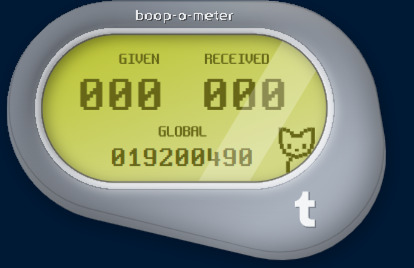
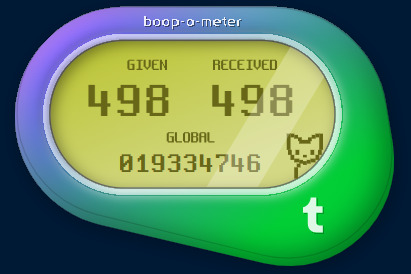

Boop count: 0 Boop count: 500 Boop count: 1000
Boop fact: the colors do not change after 1000
LOL:
Between boops 1000 and 1500, the boop-o-meter changed to display 'LOL'. This likely took place at 1000 boops, but maybe it said 'MAX' or sumn for awhile at first? Idk this is already the misinformation website so not my problem.

Boop count: 1500 (actually more like 1490 ish)
More results below the cut
OMG:
Between 1500 and 2000, the boop-o-meter changed to display 'OMG'. Again, this probably happened at 1500 but who knows. Maybe staff made it 1523 for the bit or something.

Boop count: ~2000
WOW:
The boop-o-meter remained at omg until the 3500 boop readpoint, when it switched to 'WOW', meaning this transition happens somewhere between ~2980 and ~3480.

Boop count: ~3500
Boop fact: 'WOW' is the second longest reigning message
*-*:
Between 5000 and 5500 the boop-o-meter switched to '*-*'. You get the idea at this point so I'll speed it up.
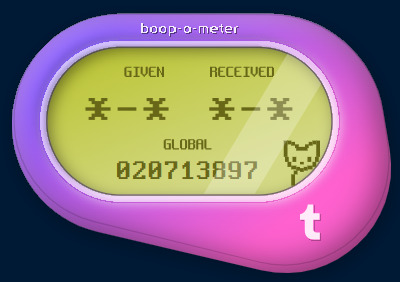
Boop count: ~5500
WHY:
The boop-o-meter changed to 'WHY' between 6000 and 6500 boops. For science. That's why.

Boop count: ~6500
PLZ:
Next was 'PLZ', switching between 7000 and 7500.

Boop count: ~7500
AAA:
I'm not sure what bloody urine has to do with anything, but for some reason staff felt is was important to display, switching between 7500 and 8000.

Boop count: ~8000
;_;:
Huh the colon makes that one look weird. 8000-8500.

Boop count: ~8500
Boop fact: That fucking cat haunts me in my dreams
0_0:
I realized after I set my pyautogui script running that my computer wouldn't turn off its screen because of the clicking, so there was a strobing blue light in my room all night. This encapsulated my expression while trying to sleep (8500-9000).
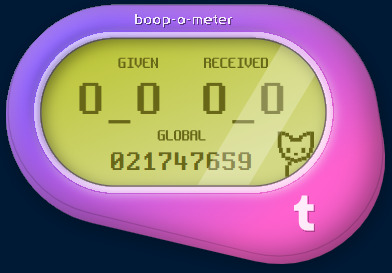
Boop count: ~9000
MAX:
After 9000 it displayed 'MAX'. This was cap. (9000-9500 switch).

Boop count: OVER 9000 (9500)
<33:
I miss my wife. 9500-10,000.

Boop count ~10,000
TUM BLR:
THE HOLY GRAIL. The boop-o-meter switched to displaying 'TUM BLR' between 10,000 and 10,500 boops. Because my actual boop count was slightly behind my theoretical, I'd guess that this change happened at 10,000 boops.

Boop count: ~10,500 (likely switched at 10,000)
Summary:
When charted the boop curve looks as follows:

Boop curve: 0 - 10,000 boops
My script continued to run until 53,000 boops, but no further changes were observed. Again, there were quite possibly more messages at lower boop values, but my ass is not checking. Maybe I should have scaled my sampling accordingly, but it is what it is. Thank you for joining me on this journey, and if you have any corrections or more information, please add it to this post.
Boop fact: Terfs DNI
7K notes
·
View notes
Text
Post #90: The pillars of object-oriented programming: Object, Class, Inheritance, Polymorphism, Abstraction and Encapsulation, 2023.
The concept of object oriented programming explained
Object-oriented programming is a fundamental concept present in numerous programming languages such as C++, Java, JavaScript, and more. It becomes straightforward once you truly grasp it, and that's precisely what this post aims to help you achieve. So, stop your scrolling for a second and delve into this post for a thorough and clear explanation.

Understanding the Term "Object-Oriented"
To grasp OOP, let's begin by explaining the name itself: "Object-Oriented." This term signifies that OOP revolves around entities known as "objects."
What Exactly Is an Object?
An object in OOP is any entity that possesses both state and behavior. Consider a dog as an example: it has states such as color, name, and breed, while its behaviors encompass actions like wagging the tail, barking, and eating.
The reason we introduce the concept of objects in programming is to effectively represent real-world entities, a task that cannot be accomplished with conventional variables or arrays.
Classes: Abstract Forms of Objects
Now, what about classes? A class is essentially the abstract form of an object. If we take the example of a "dog," the object "Mydog" is a concrete instance, while the class "dog" represents dogs in a more general sense. Think of a class as a blueprint or template from which you can create individual objects.
Four Pillars of Object-Oriented Programming
Now that we've established the fundamentals of objects and classes. OOP is built upon four key principles:
Inheritance: Inheritance occurs when one object inherits all the properties and behaviors of a parent object. It promotes code reusability and facilitates runtime polymorphism.
Polymorphism: Polymorphism entails performing a single task in multiple ways. For instance, it can involve presenting information differently to customers or implementing different shapes like triangles or rectangles.
Abstraction: Abstraction is about concealing internal details while exposing functionality. Consider a phone call; we don't need to understand the intricate inner workings.
Encapsulation: Encapsulation involves bundling code and data into a single unit. Just like a capsule contains various medicines . In a fully encapsulated class (e.g., a Java bean), all data members are private, ensuring data integrity and controlled access.
I remember finding these images that explained these concepts using the 'Squid Game' series, and they are just perfect. So, I'm sharing them here and giving all credit to their owner :
Polymorphism , Inheritance , Encapsulation
#code#python#programming#oop#object oriented programming#class#object#inheritance#polymorphism#encapsulation#abstraction#programmierung#paradigma#paradigm#i love coding#learn python#python coding
44 notes
·
View notes
Text
Happy 99th Birthday David Attenborough!
1. 1954 - Wildlife for the masses
Sir David Attenborough joined the BBC as a trainee in 1952, having only ever watched one television programme.
His early career included the high octane round-table debate, Animal, Vegetable, Mineral? But the tenacious 28-year-old was seeking new ways to make films and a life outside the television studio. The result was the hit series 'Zoo Quest,' which combined live studio presentation with footage shot on location for the first time. It brought rare animals - including chimpanzees, pythons and birds of paradise - into viewers' living rooms and proved wildlife programmes could attract big audiences.
2. 1965 - Civilisation – in colour!
We can't attribute Western civilisation to Attenborough, but we can give him the credit for one of its greatest achievements: colour television.
As Controller of BBC Two, he oversaw the first ever-colour broadcasts in Europe, rushing to beat rival German broadcasters by three weeks. He then commissioned the critically-acclaimed series Civilisation, written and presented by art historian Kenneth Clark. The Ascent of Man, presented by humanist scientist Jacob Bronowski, soon followed. These landmark series helped inaugurate a new kind of television documentary, putting history, culture and science on screen in ways never seen before.
3. 1969 - Monty Python's Flying Circus
By now BBC Director of Programmes, Attenborough continued to innovate and reinvent television – but this time in the world of comedy.
He commissioned Monty Python's Flying Circus, a cult sketch show which made stars out of John Cleese, Michael Palin, Terry Jones, Eric Idle, Graham Chapman and Terry Gilliam. The show was a global phenomenon, inspiring generations of comedians around the world. In Britain, Python became part of the nation's cultural DNA, encapsulating a recognisably British eccentricity and spawning popular catchphrases and figures of speech.
4. 1975 - Back to nature
Long before Bear Grylls slept in a camel carcass (ew), Sir David was trekking through uncharted wilderness to film some of the remotest people on earth.
Freed from his role as a BBC executive, Attenborough went back to nature to become an explorer. He made a series of programmes about tribes, some so isolated it's thought they hadn't been contacted by Europeans before Sir David's arrival. He immersed himself in their cultures, wearing nothing but a loin cloth while filming in the Solomon Islands. In showing us ways of life so different from our own, Sir David helped us understand both the diversity and universality of the human experience.
5. 1979 - Inventing epics
Now a staple of any self-respecting Brit’s television diet, Sir David helped invent the natural history documentary as we know it today.
In the late 1970s, he took inspiration from series like Civilisation and The Ascent of Man and travelled the globe to deliver his definitive take on the wonders of the natural world. A natural history programme of this scale and ambition had never been attempted before. The result was Life on Earth, a televisual feast which used stunning photography and innovative camera techniques to show animals in their natural habitats. It’s estimated that 500 million people watched the series worldwide.
6. 1994 - A rose by any other name…
While filming The Private Life of Plants, Sir David noticed the world's largest flowering plant had quite a racy name – the Amorphophallus Titanum.
Instead, he gave it another name in his script - titum arum - coining the plant's common name in the process. But as well as naming species, many plants and animals have been named after Sir David. They include a flightless beetle, a species of hawkweed found only in the Brecon Beacons and a long-necked dinosaur called the Attenborosaurus.
7. 2001 - Your first glimpse
Without the ambition and persistence of Attenborough and his collaborators, millions of us may never have seen some of the world's rarest creatures.
It's been a constant theme throughout his career, beginning with Zoo Quest in the 1950s, when he famously caught the elusive Komodo Dragon on film for the first time. But in 2001, we were given an insight into a strange new world, when Attenborough narrated The Blue Planet. The series introduced millions to the wonders of the deep sea and was the first time some species, including the hairy angler fish and the Dumbo octopus, were captured on film.
8. 2015 - Pushing boundaries
From colour broadcasts to 3D television, Sir David has always been at the forefront of pioneering technology in broadcasting.
In 2015, he dived 1,000ft in a submersible off the Australian coast to film previously unseen parts of the Great Barrier Reef, breaking the record for the deepest ever dive on the reef. He also collaborated with the Natural History Museum on a virtual reality project, and filmed BBC series – such as Planet Earth II and Wild Isles – in Ultra HD. Next time you tune into a major Attenborough documentary, you can be pretty sure you're witnessing a breakthrough in future broadcasting technology.
9. Today - Saving the world
Sir David has always said he didn't start making programmes with conservation in mind - he simply enjoyed observing the natural world.
But as time passed, he became aware that the animals and habitats he was filming were under threat. He's authored documentaries which overtly tackle environmental issues but prefers a subtler approach, showcasing the natural world in the hope we might be inspired to preserve it. Sir David has done more than almost any other person to help millions of us understand and appreciate the wonders of the world around us.
youtube
53 notes
·
View notes
Text
Honestly, I think we need to talk more often about the exotic pet trade. It’s such a threat to wild populations of animals all over the world. Anytime i see a post on here that’s like “look at this cute animal you probably haven’t heard of!” I weep over the truth that the more people hear about it, the more they will poach it from the land.
And I ask myself…why are people doing this? Why are we trying to take these often endangered animals from their habitat even as we know it won’t help them?
And I think to my own self. When I was 19, working in an exotic pet store, having just left a childhood full of times in the woods and farm animals. I came to a city that felt like it had none of that. The little glass boxes felt like encapsulations of the nature I had grown up around and sorely come to miss. If I couldn’t have it outside, I thought, I would have it inside. My coworkers and I all talked and watched videos about building little ecosystems for our little pets. It felt exciting. It felt connecting.
But the issue is that these aren’t ecosystems. They are often perpetual death machines of capture, and they often lead to disruption of the native ecosystems you’re actually yearning for. Hell, look at Florida. Hundreds of invasive animals, including everything from great large pythons to little isopods, all brought in through the pet trade. Look at Australia. Species decimated by poaching. Read about all the little monkeys of the world, and what we have done by owning them.
There are entire industries wrapped up in the poaching of wild animals, the breeding of them, the housing of them, the feeding of them. Even some of the most well respected and supposedly ethical people in the trade still think there are different ethics for breeders and normal keepers. They store their animals in minimalistic tiny enclosures. Thousands upon thousands of rats and crickets are bred just to maintain the feed supply to the trade and its customers, creating an endless wheel of suffering and disease conditions. And I must ask, why? For what purpose? It’s not conservation. These aren’t concerned groups creating sanctuary populations for wildlife reintroduction. They aren’t growing things for food, or leather, or research. All of those we can discuss the ethics of, sure, but at least then there is a reason. What is the reason here? Just to have a hollow stare at a sad creature and pretend that is love? Just to propagate more environmental destruction with our ongoing thievery of peat moss and orchids for our tanks?
And still then are the collectors. I’ve met people with hundreds of animals placed in shoe storage racks, living their lives for no purpose other than the occasional glance and the feeling of having a hoard.
We all feel so disconnected from the environment that we are willing to rob other areas of the world, we are willing to further endanger these species we love, we are willing to terrorize the ecosystems we are unknowingly in, all due to our incredible and violent loneliness.
But this is a solvable problem.
Learn to live where you are. Learn to love the things you can find around you. Plant native plants, you will see native birds and wildlife. If you don’t have a yard, offer to care for the yard of an older neighbor, if they will let you use native plant landscaping in exchange. If you truly cannot connect where you are, to its people and to its ecosystems, then research somewhere and move. But don’t live your life with one foot out the door, hating where you are and doing nothing, dreaming or elsewhere and never leaving.
You do not need to collect rare morphs of isopods. My friend, I see so many beautiful native ones outside in the habitat I have helped manage for them. I see swallowtail butterflies and chimney swifts and solitary bees and little snakes and salamanders and anoles. I learn their species names and watch their behaviors. I see what they eat, where they hide, what times of year they are around. And I feel, finally, connected. Everything I was looking for in the commodity of exotic pets, I found in the reality just outside my door. I have nurtured it and it has nurtured me.
Owning that cute monkey won’t fix you. But having a relationship with the ecology around you just might begin to.
#rose baker#text post#ecology#environment#enviromentalism#ecosystems#pets#pet trade#exotic pets#conservation#native plants
20 notes
·
View notes
Text
Took me four hours but I was able to convert and format a Mandarin epub to include pinyin notation above the text:
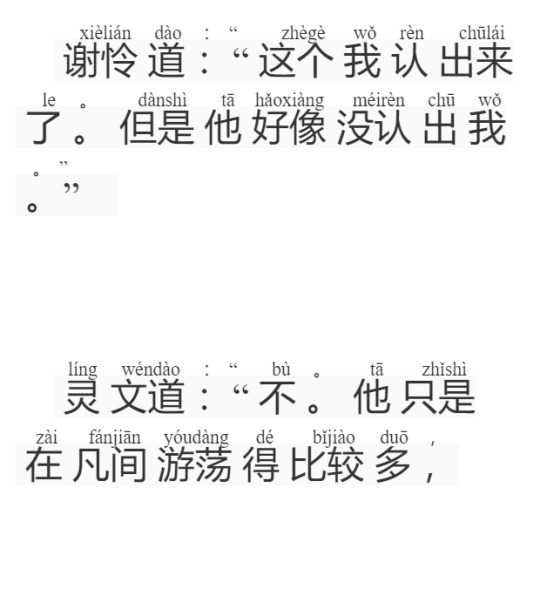
Technical details below for anyone interested
I was trying to do this on my personal laptop, which is, unfortunately, Windows. I found two GitHub projects that looked promising: pinyin2epub and epub-with-pinyin and spent most of my time trying to get python to work. I wasn't able to get the second project to work, but I was eventually able to get some output with the pinyin2epub project.
The output was super messy though, with each word appearing on a different line. The script output the new ePub where all the tags that encapsulated every word and pinyin were on a new line, as well as having a ton of extra spacing.
I downloaded Calibre and edited the epub. With the help of regex search and replace I was able to adjust the formatting to what is shown in the picture above.
All in all, I'm fairly happy with it although it does fail to load correctly in any mobile ePub reader I've tried so far ( I have an Android). I think it's the <ruby> tags are either unsupported or cause a processing error entirely depending on the app.
Once I have motivation again I'd love to try to combine the original text epub with a translated epub. My idea here is that there would be a line of the original text above followed by a line of the translate text so on and so forth. I'd probably need to script something for this, maybe it could look for paragraph tags and alternate from two input files. I'd have to think about it a bit more though.
Unfortunately my Mandarin isn't yet strong enough to read the novels I'm interested in entirely in the original language, but I'd love to be able to quickly reference the original text to see what word or character they used, or how a phrase is composed
Feel free to ask if you want to try to do this and need any clarification. The crappy screenshot and lack of links because I'm on my phone and lazy.
114 notes
·
View notes
Text
Python Programming Language: A Comprehensive Guide
Python is one of the maximum widely used and hastily growing programming languages within the world. Known for its simplicity, versatility, and great ecosystem, Python has become the cross-to desire for beginners, professionals, and organizations across industries.
What is Python used for

🐍 What is Python?
Python is a excessive-stage, interpreted, fashionable-purpose programming language. The language emphasizes clarity, concise syntax, and code simplicity, making it an excellent device for the whole lot from web development to synthetic intelligence.
Its syntax is designed to be readable and easy, regularly described as being near the English language. This ease of information has led Python to be adopted no longer simplest through programmers but also by way of scientists, mathematicians, and analysts who may not have a formal heritage in software engineering.
📜 Brief History of Python
Late Nineteen Eighties: Guido van Rossum starts work on Python as a hobby task.
1991: Python zero.9.0 is released, presenting classes, functions, and exception managing.
2000: Python 2.Zero is launched, introducing capabilities like list comprehensions and rubbish collection.
2008: Python 3.Zero is launched with considerable upgrades but breaks backward compatibility.
2024: Python three.12 is the modern day strong model, enhancing performance and typing support.
⭐ Key Features of Python
Easy to Learn and Use:
Python's syntax is simple and similar to English, making it a high-quality first programming language.
Interpreted Language:
Python isn't always compiled into device code; it's far done line by using line the usage of an interpreter, which makes debugging less complicated.
Cross-Platform:
Python code runs on Windows, macOS, Linux, and even cell devices and embedded structures.
Dynamic Typing:
Variables don’t require explicit type declarations; types are decided at runtime.
Object-Oriented and Functional:
Python helps each item-orientated programming (OOP) and practical programming paradigms.
Extensive Standard Library:
Python includes a rich set of built-in modules for string operations, report I/O, databases, networking, and more.
Huge Ecosystem of Libraries:
From data technological know-how to net development, Python's atmosphere consists of thousands of programs like NumPy, pandas, TensorFlow, Flask, Django, and many greater.
📌 Basic Python Syntax
Here's an instance of a easy Python program:
python
Copy
Edit
def greet(call):
print(f"Hello, call!")
greet("Alice")
Output:
Copy
Edit
Hello, Alice!
Key Syntax Elements:
Indentation is used to define blocks (no curly braces like in different languages).
Variables are declared via task: x = 5
Comments use #:
# This is a remark
Print Function:
print("Hello")
📊 Python Data Types
Python has several built-in data kinds:
Numeric: int, go with the flow, complicated
Text: str
Boolean: bool (True, False)
Sequence: listing, tuple, range
Mapping: dict
Set Types: set, frozenset
Example:
python
Copy
Edit
age = 25 # int
name = "John" # str
top = 5.Nine # drift
is_student = True # bool
colors = ["red", "green", "blue"] # listing
🔁 Control Structures
Conditional Statements:
python
Copy
Edit
if age > 18:
print("Adult")
elif age == 18:
print("Just became an person")
else:
print("Minor")
Loops:
python
Copy
Edit
for color in hues:
print(coloration)
while age < 30:
age += 1
🔧 Functions and Modules
Defining a Function:
python
Copy
Edit
def upload(a, b):
return a + b
Importing a Module:
python
Copy
Edit
import math
print(math.Sqrt(sixteen)) # Output: four.0
🗂️ Object-Oriented Programming (OOP)
Python supports OOP functions such as lessons, inheritance, and encapsulation.
Python
Copy
Edit
elegance Animal:
def __init__(self, call):
self.Call = name
def communicate(self):
print(f"self.Call makes a valid")
dog = Animal("Dog")
dog.Speak() # Output: Dog makes a legitimate
🧠 Applications of Python
Python is used in nearly each area of era:
1. Web Development
Frameworks like Django, Flask, and FastAPI make Python fantastic for building scalable web programs.
2. Data Science & Analytics
Libraries like pandas, NumPy, and Matplotlib permit for data manipulation, evaluation, and visualization.
Three. Machine Learning & AI
Python is the dominant language for AI, way to TensorFlow, PyTorch, scikit-research, and Keras.
4. Automation & Scripting
Python is extensively used for automating tasks like file managing, device tracking, and data scraping.
Five. Game Development
Frameworks like Pygame allow builders to build simple 2D games.
6. Desktop Applications
With libraries like Tkinter and PyQt, Python may be used to create cross-platform computing device apps.
7. Cybersecurity
Python is often used to write security equipment, penetration trying out scripts, and make the most development.
📚 Popular Python Libraries
NumPy: Numerical computing
pandas: Data analysis
Matplotlib / Seaborn: Visualization
scikit-study: Machine mastering
BeautifulSoup / Scrapy: Web scraping
Flask / Django: Web frameworks
OpenCV: Image processing
PyTorch / TensorFlow: Deep mastering
SQLAlchemy: Database ORM
💻 Python Tools and IDEs
Popular environments and tools for writing Python code encompass:
PyCharm: Full-featured Python IDE.
VS Code: Lightweight and extensible editor.
Jupyter Notebook: Interactive environment for statistics technological know-how and studies.
IDLE: Python’s default editor.
🔐 Strengths of Python
Easy to study and write
Large community and wealthy documentation
Extensive 0.33-birthday celebration libraries
Strong support for clinical computing and AI
Cross-platform compatibility
⚠️ Limitations of Python
Slower than compiled languages like C/C++
Not perfect for mobile app improvement
High memory usage in massive-scale packages
GIL (Global Interpreter Lock) restricts genuine multithreading in CPython
🧭 Learning Path for Python Beginners
Learn variables, facts types, and control glide.
Practice features and loops.
Understand modules and report coping with.
Explore OOP concepts.
Work on small initiatives (e.G., calculator, to-do app).
Dive into unique areas like statistics technological know-how, automation, or web development.
#What is Python used for#college students learn python#online course python#offline python course institute#python jobs in information technology
2 notes
·
View notes
Text
Object-Oriented Programming (OOP) Explaine
Object-Oriented Programming (OOP) is a programming paradigm based on the concept of "objects," which represent real-world entities. Objects combine data (attributes) and functions (methods) into a single unit. OOP promotes code reusability, modularity, and scalability, making it a popular approach in modern software development.
Core Concepts of Object-Oriented Programming
Classes and Objects
Class: A blueprint or template for creating objects. It defines properties (attributes) and behaviors (methods).
Object: An instance of a class. Each object has unique data but follows the structure defined by its
Encapsulations
Encapsulation means bundling data (attributes) and methods that operate on that data within a class. It protects object properties by restricting direct access.
Access to attributes is controlled through getter and setter methods.Example: pythonCopyEditclass Person: def __init__(self, name): self.__name = name # Private attribute def get_name(self): return self.__name person = Person("Alice") print(person.get_name()) # Output: Alice
Inheritance
Inheritance allows a class (child) to inherit properties and methods from another class (parent). It promotes code reuse and hierarchical relationships.Example: pythonCopyEditclass Animal: def speak(self): print("Animal speaks") class Dog(Animal): def speak(self): print("Dog barks") dog = Dog() dog.speak() # Output: Dog barks
Polymorphism
Polymorphism allows methods to have multiple forms. It enables the same function to work with different object types.
Two common types:
Method Overriding (child class redefines parent method).
Method Overloading (same method name, different parameters – not natively supported in Python).Example: pythonCopyEditclass Bird: def sound(self): print("Bird chirps") class Cat: def sound(self): print("Cat meows") def make_sound(animal): animal.sound() make_sound(Bird()) # Output: Bird chirps make_sound(Cat()) # Output: Cat meows
Abstraction
Abstraction hides complex implementation details and shows only the essential features.
In Python, this is achieved using abstract classes and methods (via the abc module).Example: pythonCopyEditfrom abc import ABC, abstractmethod class Shape(ABC): @abstractmethod def area(self): pass class Circle(Shape): def __init__(self, radius): self.radius = radius def area(self): return 3.14 * self.radius * self.radius circle = Circle(5) print(circle.area()) # Output: 78.5
Advantages of Object-Oriented Programming
Code Reusability: Use inheritance to reduce code duplication.
Modularity: Organize code into separate classes, improving readability and maintenance.
Scalability: Easily extend and modify programs as they grow.
Data Security: Protect sensitive data using encapsulation.
Flexibility: Use polymorphism for adaptable and reusable methods.
Real-World Applications of OOP
Software Development: Used in large-scale applications like operating systems, web frameworks, and databases.
Game Development: Objects represent game entities like characters and environments.
Banking Systems: Manage customer accounts, transactions, and security.
E-commerce Platforms: Handle products, users, and payment processing.
Machine Learning: Implement models as objects for efficient training and prediction.
Conclusion
Object-Oriented Programming is a powerful paradigm that enhances software design by using objects, encapsulation, inheritance, polymorphism, and abstraction. It is widely used in various industries to build scalable, maintainable, and efficient applications. Understanding and applying OOP principles is essential for modern software development.
: pythonCopyEdit
class Car: def __init__(self, brand, model): self.brand = brand self.model = model def display_info(self): print(f"Car: {self.brand} {self.model}") my_car = Car("Toyota", "Camry") my_car.display_info() # Output: Car: Toyota Camry
Encapsulation
2 notes
·
View notes
Text
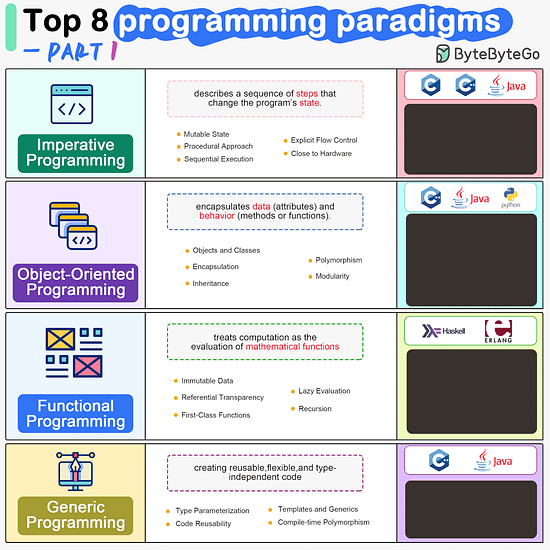
ByteByteGo | Newsletter/Blog
From the newsletter:
Imperative Programming Imperative programming describes a sequence of steps that change the program’s state. Languages like C, C++, Java, Python (to an extent), and many others support imperative programming styles.
Declarative Programming Declarative programming emphasizes expressing logic and functionalities without describing the control flow explicitly. Functional programming is a popular form of declarative programming.
Object-Oriented Programming (OOP) Object-oriented programming (OOP) revolves around the concept of objects, which encapsulate data (attributes) and behavior (methods or functions). Common object-oriented programming languages include Java, C++, Python, Ruby, and C#.
Aspect-Oriented Programming (AOP) Aspect-oriented programming (AOP) aims to modularize concerns that cut across multiple parts of a software system. AspectJ is one of the most well-known AOP frameworks that extends Java with AOP capabilities.
Functional Programming Functional Programming (FP) treats computation as the evaluation of mathematical functions and emphasizes the use of immutable data and declarative expressions. Languages like Haskell, Lisp, Erlang, and some features in languages like JavaScript, Python, and Scala support functional programming paradigms.
Reactive Programming Reactive Programming deals with asynchronous data streams and the propagation of changes. Event-driven applications, and streaming data processing applications benefit from reactive programming.
Generic Programming Generic Programming aims at creating reusable, flexible, and type-independent code by allowing algorithms and data structures to be written without specifying the types they will operate on. Generic programming is extensively used in libraries and frameworks to create data structures like lists, stacks, queues, and algorithms like sorting, searching.
Concurrent Programming Concurrent Programming deals with the execution of multiple tasks or processes simultaneously, improving performance and resource utilization. Concurrent programming is utilized in various applications, including multi-threaded servers, parallel processing, concurrent web servers, and high-performance computing.
#bytebytego#resource#programming#concurrent#generic#reactive#funtional#aspect#oriented#aop#fp#object#oop#declarative#imperative
8 notes
·
View notes
Text
Encapsulation in Java – A Complete Guide
Learn everything about Encapsulation in Java with Scientech Easy's beginner-friendly guide. Understand how encapsulation helps in data hiding, improves code maintainability, and secures your Java applications. This comprehensive article covers its real-world use, syntax, and practical examples to help you grasp the concept easily. Perfect for students and developers looking to strengthen their OOP fundamentals.Scientech Easy for clear explanations and step-by-step learning on Java programming topics. Start mastering encapsulation today!

#bca course subjects#python tuple#Interface in Java#Encapsulation in Java#Method overriding in Java#Polymorphism in Java#Constructor in java
0 notes
Note
Experience with rust thus far
Rust is great! I've been working with it off and on for around a year and change now, and I have no complaints.
It's a very... sane language. At no point have I looked at a language feature and thought "wow that's a hack", which has been my experience with almost every other imperative language to that point. (Java, C, C#, JavaScript, Python, etc.) There are a few features I think it's currently lacking, but most of them are present in the nightly branch. (I'm a big fan of let_chains and const_fn_floating_point_arithmetic, among others.)
Library support via Cargo is great, no complaints, and I love how easy doc comments are to write, it makes for an almost Elisp level of good documentation.
I've written a few non-trivial applications, like a breakout clone and a flappy bird-esque thing, and while I ditched good practices for the sake of implementation efficiency (both projects were more about learning libraries than the final product) Rust's nature makes it really easy to refactor from copy-paste spaghetti hell into clean, encapsulated, maintainable code.
I also love how anal-retentive the compiler is. Again, Rust is a very sane language. I do not want to be writing Raku, where there are a thousand "basically correct" ways to do the same thing. I want constraints, and I want them strict. I want to be able to express to the compiler not just what I want a piece of code to do, but what I don't want it to do as well. We're all human! We're gonna mess up! I want it to be easy to tell that I've messed up! (Looking at you, python, with your assignment equals declaration bullshit. Typoing a variable name should not be permitted.)
Overall it's just great. When it comes to writing applications I'd pick no other language. (Except maybe D. Too bad nobody supports D...)
#ive probably missed some stuff here#but thats the general picture#my thoughts#programming#rustlang#thanks for the ask!#your thoughts
5 notes
·
View notes
Text

For this week's Tumblr post, I decided to pick this meme originally from Monty Python and the Holy Grail. Monty Python and the Holy Grail is a movie that takes place in the Middle Ages and tells the story of King Arthur. In the scene, King Arthur meets two peasants and a heated exchange over government systems breaks out.
I felt like this meme really encapsulates the feeling of Fanny Price and also covers some of the topics that were discussed in class about Fanny. Our conversation about Fanny being a main character was very interesting due to the fact she doesn't exemplify any main character traits. One of the main traits that we fail to see with Fanny is her pushback against the repressive and disrespectful behavior she's faced with.
A lot of times when main characters are faced with repressive behavior, even if they don't vocally voice their feelings about it, we'll get to see what they internally think about it. As for Fanny, we don't hear her vocally speak out but Jane Austen also doesn't write about Fanny's internal monologue. I think this meme works in two ways, she's being repressed by her family but also by Jane Austen. Jane Austen doesn't let the reader's get to see what goes on in Fanny's head and see how she truthfully feels about things. But this also could be to show that Fanny keeps her true feelings hidden from her family but also from everyone in general, including the readers.
That all plays into the fact that Fanny is very reserved and the only person she somewhat opens up to and is herself around is Edmund since he's the only one who cares. In that sense, she exhibits main character behavior. A lot time when there's a main character who's going through some type of struggle, there's always at least one person who they open up to about the issue. While Fanny doesn't talk to Edmund about the repression she faces, she's more herself around him.
2 notes
·
View notes
Text
Learning About Different Types of Functions in R Programming
Summary: Learn about the different types of functions in R programming, including built-in, user-defined, anonymous, recursive, S3, S4 methods, and higher-order functions. Understand their roles and best practices for efficient coding.
Introduction
Functions in R programming are fundamental building blocks that streamline code and enhance efficiency. They allow you to encapsulate code into reusable chunks, making your scripts more organised and manageable.
Understanding the various types of functions in R programming is crucial for leveraging their full potential, whether you're using built-in, user-defined, or advanced methods like recursive or higher-order functions.
This article aims to provide a comprehensive overview of these different types, their uses, and best practices for implementing them effectively. By the end, you'll have a solid grasp of how to utilise these functions to optimise your R programming projects.
What is a Function in R?
In R programming, a function is a reusable block of code designed to perform a specific task. Functions help organise and modularise code, making it more efficient and easier to manage.
By encapsulating a sequence of operations into a function, you can avoid redundancy, improve readability, and facilitate code maintenance. Functions take inputs, process them, and return outputs, allowing for complex operations to be performed with a simple call.
Basic Structure of a Function in R
The basic structure of a function in R includes several key components:
Function Name: A unique identifier for the function.
Parameters: Variables listed in the function definition that act as placeholders for the values (arguments) the function will receive.
Body: The block of code that executes when the function is called. It contains the operations and logic to process the inputs.
Return Statement: Specifies the output value of the function. If omitted, R returns the result of the last evaluated expression by default.
Here's the general syntax for defining a function in R:

Syntax and Example of a Simple Function
Consider a simple function that calculates the square of a number. This function takes one argument, processes it, and returns the squared value.

In this example:
square_number is the function name.
x is the parameter, representing the input value.
The body of the function calculates x^2 and stores it in the variable result.
The return(result) statement provides the output of the function.
You can call this function with an argument, like so:

This function is a simple yet effective example of how you can leverage functions in R to perform specific tasks efficiently.
Must Read: R Programming vs. Python: A Comparison for Data Science.
Types of Functions in R
In R programming, functions are essential building blocks that allow users to perform operations efficiently and effectively. Understanding the various types of functions available in R helps in leveraging the full power of the language.
This section explores different types of functions in R, including built-in functions, user-defined functions, anonymous functions, recursive functions, S3 and S4 methods, and higher-order functions.
Built-in Functions
R provides a rich set of built-in functions that cater to a wide range of tasks. These functions are pre-defined and come with R, eliminating the need for users to write code for common operations.
Examples include mathematical functions like mean(), median(), and sum(), which perform statistical calculations. For instance, mean(x) calculates the average of numeric values in vector x, while sum(x) returns the total sum of the elements in x.
These functions are highly optimised and offer a quick way to perform standard operations. Users can rely on built-in functions for tasks such as data manipulation, statistical analysis, and basic operations without having to reinvent the wheel. The extensive library of built-in functions streamlines coding and enhances productivity.
User-Defined Functions
User-defined functions are custom functions created by users to address specific needs that built-in functions may not cover. Creating user-defined functions allows for flexibility and reusability in code. To define a function, use the function() keyword. The syntax for creating a user-defined function is as follows:

In this example, my_function takes two arguments, arg1 and arg2, adds them, and returns the result. User-defined functions are particularly useful for encapsulating repetitive tasks or complex operations that require custom logic. They help in making code modular, easier to maintain, and more readable.
Anonymous Functions
Anonymous functions, also known as lambda functions, are functions without a name. They are often used for short, throwaway tasks where defining a full function might be unnecessary. In R, anonymous functions are created using the function() keyword without assigning them to a variable. Here is an example:

In this example, sapply() applies the anonymous function function(x) x^2 to each element in the vector 1:5. The result is a vector containing the squares of the numbers from 1 to 5.
Anonymous functions are useful for concise operations and can be utilised in functions like apply(), lapply(), and sapply() where temporary, one-off computations are needed.
Recursive Functions
Recursive functions are functions that call themselves in order to solve a problem. They are particularly useful for tasks that can be divided into smaller, similar sub-tasks. For example, calculating the factorial of a number can be accomplished using recursion. The following code demonstrates a recursive function for computing factorial:

Here, the factorial() function calls itself with n - 1 until it reaches the base case where n equals 1. Recursive functions can simplify complex problems but may also lead to performance issues if not implemented carefully. They require a clear base case to prevent infinite recursion and potential stack overflow errors.
S3 and S4 Methods
R supports object-oriented programming through the S3 and S4 systems, each offering different approaches to object-oriented design.
S3 Methods: S3 is a more informal and flexible system. Functions in S3 are used to define methods for different classes of objects. For instance:

In this example, print.my_class is a method that prints a custom message for objects of class my_class. S3 methods provide a simple way to extend functionality for different object types.
S4 Methods: S4 is a more formal and rigorous system with strict class definitions and method dispatch. It allows for detailed control over method behaviors. For example:

Here, setClass() defines a class with a numeric slot, and setMethod() defines a method for displaying objects of this class. S4 methods offer enhanced functionality and robustness, making them suitable for complex applications requiring precise object-oriented programming.
Higher-Order Functions
Higher-order functions are functions that take other functions as arguments or return functions as results. These functions enable functional programming techniques and can lead to concise and expressive code. Examples include apply(), lapply(), and sapply().
apply(): Used to apply a function to the rows or columns of a matrix.
lapply(): Applies a function to each element of a list and returns a list.
sapply(): Similar to lapply(), but returns a simplified result.
Higher-order functions enhance code readability and efficiency by abstracting repetitive tasks and leveraging functional programming paradigms.
Best Practices for Writing Functions in R
Writing efficient and readable functions in R is crucial for maintaining clean and effective code. By following best practices, you can ensure that your functions are not only functional but also easy to understand and maintain. Here are some key tips and common pitfalls to avoid.
Tips for Writing Efficient and Readable Functions
Keep Functions Focused: Design functions to perform a single task or operation. This makes your code more modular and easier to test. For example, instead of creating a function that processes data and generates a report, split it into separate functions for processing and reporting.
Use Descriptive Names: Choose function names that clearly indicate their purpose. For instance, use calculate_mean() rather than calc() to convey the function’s role more explicitly.
Avoid Hardcoding Values: Use parameters instead of hardcoded values within functions. This makes your functions more flexible and reusable. For example, instead of using a fixed threshold value within a function, pass it as a parameter.
Common Mistakes to Avoid
Overcomplicating Functions: Avoid writing overly complex functions. If a function becomes too long or convoluted, break it down into smaller, more manageable pieces. Complex functions can be harder to debug and understand.
Neglecting Error Handling: Failing to include error handling can lead to unexpected issues during function execution. Implement checks to handle invalid inputs or edge cases gracefully.
Ignoring Code Consistency: Consistency in coding style helps maintain readability. Follow a consistent format for indentation, naming conventions, and comment style.
Best Practices for Function Documentation
Document Function Purpose: Clearly describe what each function does, its parameters, and its return values. Use comments and documentation strings to provide context and usage examples.
Specify Parameter Types: Indicate the expected data types for each parameter. This helps users understand how to call the function correctly and prevents type-related errors.
Update Documentation Regularly: Keep function documentation up-to-date with any changes made to the function’s logic or parameters. Accurate documentation enhances the usability of your code.
By adhering to these practices, you’ll improve the quality and usability of your R functions, making your codebase more reliable and easier to maintain.
Read Blogs:
Pattern Programming in Python: A Beginner’s Guide.
Understanding the Functional Programming Paradigm.
Frequently Asked Questions
What are the main types of functions in R programming?
In R programming, the main types of functions include built-in functions, user-defined functions, anonymous functions, recursive functions, S3 methods, S4 methods, and higher-order functions. Each serves a specific purpose, from performing basic tasks to handling complex operations.
How do user-defined functions differ from built-in functions in R?
User-defined functions are custom functions created by users to address specific needs, whereas built-in functions come pre-defined with R and handle common tasks. User-defined functions offer flexibility, while built-in functions provide efficiency and convenience for standard operations.
What is a recursive function in R programming?
A recursive function in R calls itself to solve a problem by breaking it down into smaller, similar sub-tasks. It's useful for problems like calculating factorials but requires careful implementation to avoid infinite recursion and performance issues.
Conclusion
Understanding the types of functions in R programming is crucial for optimising your code. From built-in functions that simplify tasks to user-defined functions that offer customisation, each type plays a unique role.
Mastering recursive, anonymous, and higher-order functions further enhances your programming capabilities. Implementing best practices ensures efficient and maintainable code, leveraging R’s full potential for data analysis and complex problem-solving.
#Different Types of Functions in R Programming#Types of Functions in R Programming#r programming#data science
4 notes
·
View notes
Text
Nothing encapsulates my misgivings with Docker as much as this recent story. I wanted to deploy a PyGame-CE game as a static executable, and that means compiling CPython and PyGame statically, and then linking the two together. To compile PyGame statically, I need to statically link it to SDL2, but because of SDL2 special features, the SDL2 code can be replaced with a different version at runtime.
I tried, and failed, to do this. I could compile a certain version of CPython, but some of the dependencies of the latest CPython gave me trouble. I could compile PyGame with a simple makefile, but it was more difficult with meson.
Instead of doing this by hand, I started to write a Dockerfile. It's just too easy to get this wrong otherwise, or at least not get it right in a reproducible fashion. Although everything I was doing was just statically compiled, and it should all have worked with a shell script, it didn't work with a shell script in practice, because cmake, meson, and autotools all leak bits and pieces of my host system into the final product. Some things, like libGL, should never be linked into or distributed with my executable.
I also thought that, if I was already working with static compilation, I could just link PyGame-CE against cosmopolitan libc, and have the SDL2 pieces replaced with a dynamically linked libSDL2 for the target platform.
I ran into some trouble. I asked for help online.
The first answer I got was "You should just use PyInstaller for deployment"
The second answer was "You should use Docker for application deployment. Just start with
FROM python:3.11
and go from there"
The others agreed. I couldn't get through to them.
It's the perfect example of Docker users seeing Docker as the solution for everything, even when I was already using Docker (actually Podman).
I think in the long run, Docker has already caused, and will continue to cause, these problems:
Over-reliance on containerisation is slowly making build processes, dependencies, and deployment more brittle than necessary, because it still works in Docker
Over-reliance on containerisation is making the actual build process outside of a container or even in a container based on a different image more painful, as well as multi-stage build processes when dependencies want to be built in their own containers
Container specifications usually don't even take advantage of a known static build environment, for example by hard-coding a makefile, negating the savings in complexity
5 notes
·
View notes
Text
Navigating the DevOps Landscape: Opportunities and Roles
DevOps has become a game-changer in the quick-moving world of technology. This dynamic process, whose name is a combination of "Development" and "Operations," is revolutionising the way software is created, tested, and deployed. DevOps is a cultural shift that encourages cooperation, automation, and integration between development and IT operations teams, not merely a set of practises. The outcome? greater software delivery speed, dependability, and effectiveness.

In this comprehensive guide, we'll delve into the essence of DevOps, explore the key technologies that underpin its success, and uncover the vast array of job opportunities it offers. Whether you're an aspiring IT professional looking to enter the world of DevOps or an experienced practitioner seeking to enhance your skills, this blog will serve as your roadmap to mastering DevOps. So, let's embark on this enlightening journey into the realm of DevOps.
Key Technologies for DevOps:
Version Control Systems: DevOps teams rely heavily on robust version control systems such as Git and SVN. These systems are instrumental in managing and tracking changes in code and configurations, promoting collaboration and ensuring the integrity of the software development process.
Continuous Integration/Continuous Deployment (CI/CD): The heart of DevOps, CI/CD tools like Jenkins, Travis CI, and CircleCI drive the automation of critical processes. They orchestrate the building, testing, and deployment of code changes, enabling rapid, reliable, and consistent software releases.
Configuration Management: Tools like Ansible, Puppet, and Chef are the architects of automation in the DevOps landscape. They facilitate the automated provisioning and management of infrastructure and application configurations, ensuring consistency and efficiency.
Containerization: Docker and Kubernetes, the cornerstones of containerization, are pivotal in the DevOps toolkit. They empower the creation, deployment, and management of containers that encapsulate applications and their dependencies, simplifying deployment and scaling.
Orchestration: Docker Swarm and Amazon ECS take center stage in orchestrating and managing containerized applications at scale. They provide the control and coordination required to maintain the efficiency and reliability of containerized systems.
Monitoring and Logging: The observability of applications and systems is essential in the DevOps workflow. Monitoring and logging tools like the ELK Stack (Elasticsearch, Logstash, Kibana) and Prometheus are the eyes and ears of DevOps professionals, tracking performance, identifying issues, and optimizing system behavior.
Cloud Computing Platforms: AWS, Azure, and Google Cloud are the foundational pillars of cloud infrastructure in DevOps. They offer the infrastructure and services essential for creating and scaling cloud-based applications, facilitating the agility and flexibility required in modern software development.
Scripting and Coding: Proficiency in scripting languages such as Shell, Python, Ruby, and coding skills are invaluable assets for DevOps professionals. They empower the creation of automation scripts and tools, enabling customization and extensibility in the DevOps pipeline.
Collaboration and Communication Tools: Collaboration tools like Slack and Microsoft Teams enhance the communication and coordination among DevOps team members. They foster efficient collaboration and facilitate the exchange of ideas and information.
Infrastructure as Code (IaC): The concept of Infrastructure as Code, represented by tools like Terraform and AWS CloudFormation, is a pivotal practice in DevOps. It allows the definition and management of infrastructure using code, ensuring consistency and reproducibility, and enabling the rapid provisioning of resources.

Job Opportunities in DevOps:
DevOps Engineer: DevOps engineers are the architects of continuous integration and continuous deployment (CI/CD) pipelines. They meticulously design and maintain these pipelines to automate the deployment process, ensuring the rapid, reliable, and consistent release of software. Their responsibilities extend to optimizing the system's reliability, making them the backbone of seamless software delivery.
Release Manager: Release managers play a pivotal role in orchestrating the software release process. They carefully plan and schedule software releases, coordinating activities between development and IT teams. Their keen oversight ensures the smooth transition of software from development to production, enabling timely and successful releases.
Automation Architect: Automation architects are the visionaries behind the design and development of automation frameworks. These frameworks streamline deployment and monitoring processes, leveraging automation to enhance efficiency and reliability. They are the engineers of innovation, transforming manual tasks into automated wonders.
Cloud Engineer: Cloud engineers are the custodians of cloud infrastructure. They adeptly manage cloud resources, optimizing their performance and ensuring scalability. Their expertise lies in harnessing the power of cloud platforms like AWS, Azure, or Google Cloud to provide robust, flexible, and cost-effective solutions.
Site Reliability Engineer (SRE): SREs are the sentinels of system reliability. They focus on maintaining the system's resilience through efficient practices, continuous monitoring, and rapid incident response. Their vigilance ensures that applications and systems remain stable and performant, even in the face of challenges.
Security Engineer: Security engineers are the guardians of the DevOps pipeline. They integrate security measures seamlessly into the software development process, safeguarding it from potential threats and vulnerabilities. Their role is crucial in an era where security is paramount, ensuring that DevOps practices are fortified against breaches.
As DevOps continues to redefine the landscape of software development and deployment, gaining expertise in its core principles and technologies is a strategic career move. ACTE Technologies offers comprehensive DevOps training programs, led by industry experts who provide invaluable insights, real-world examples, and hands-on guidance. ACTE Technologies's DevOps training covers a wide range of essential concepts, practical exercises, and real-world applications. With a strong focus on certification preparation, ACTE Technologies ensures that you're well-prepared to excel in the world of DevOps. With their guidance, you can gain mastery over DevOps practices, enhance your skill set, and propel your career to new heights.
11 notes
·
View notes